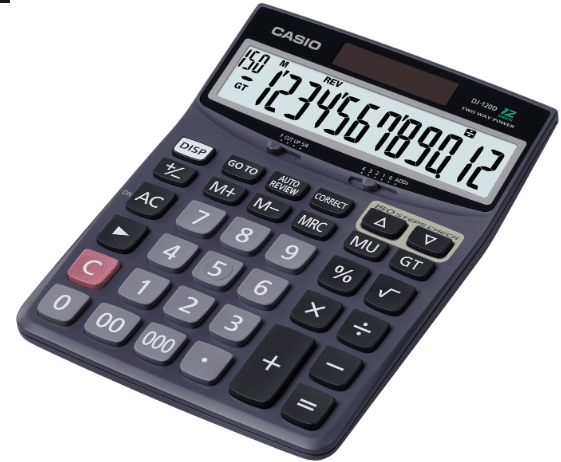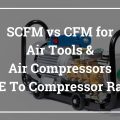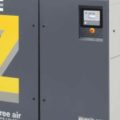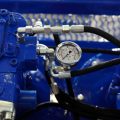Hey! This site is reader-supported and we earn commissions if you purchase products from retailers after clicking on a link from our site.
If an air compressor generates 4 CFM of compressed air at 90 PSI, how much does it generate at 50 PSI, for example? That’s what this page is all about. Calculating CFM output at various pressure levels for air compressors!
Over the years, I have received many requests for information about calculating CFM at different pressures. Almost all compressor manuals that have compressed air output information provide it at 90 PSI and sometimes at 40 PSI. Knowing the air compressor output at 90 PSI output is good since many air tools are rated on their air consumption at that pressure.
But, what if you want to know how much air your compressor puts out at 55 PSI or 20 PSI? Turns out this isn’t all that easy to figure out using the math, yet I’ve tried to help as much as possible below.
Table of Contents
- CFM vs PSI – Air Volume vs Pressure
- Why People Get Confused About PSI vs CFM On an Air Compressor
- How to Calculate CFM of Air Compressors?
- How to Calculate CFM of Air Compressor: Reader Inputs
- FAQs (Frequently Asked Questions)
- Reader Questions & Responses
CFM vs PSI – Air Volume vs Pressure
What engineers DO agree on about Air Volume vs Pressure:
- In a perfect world, if you half the volume, you double the pressure
- In a perfect world, if you double the volume, you half the pressure
We don’t live in a perfect world, and this simplistic view doesn’t apply to flowing air.
What engineers DO agree on about CFM to PSI relationship:
- The CFM at the air compressor outlet will increase if you reduce the outlet PSI
- The CFM at the air compressor outlet will decrease if you increase the outlet PSI
- The exact mathematical relationship between CFM versus PSI has lots of noise factors
It would be nice if it was as simple as “if you half the PSI at the outlet, you double the CFM at the outlet” but it’s not.
The relationship between PSI to CFM isn’t this simple because:
- Temperature also changes
- The pressure inside the compressor air tank changes as air flows
PEOPLE GET CONFUSED ABOUT THE QUESTION!
I wrote another article going into depth about what CFM actually means on an air compressor to help combat some of the confusion. So if this article feels like I’m jumping ahead, check out my explanation of CFM on Air Compressors.
Why People Get Confused About PSI vs CFM On an Air Compressor
Lots of well-meaning engineers often chip in on this subject but often forget which part of the compressed air system the air compressor users are talking about.
We should be able to all agree that the air compressor pump is designed to produce air at a certain flow rate and a certain pressure efficiently. If we change the pressure or CFM that the air compressor pump needs to operate at – we’ll have lots of efficiency losses. Meaning the relationship between CFM and PSI gets very complex.
Air Tank Outlet CFM to PSI vs Air Compressor Pump PSI to CFM
However… let’s ignore the air compressor pump for a moment and just concentrate on the compressed air tank.
If a compressed air TANK has a regulator attached to it which is set to 90 PSI and the air in the tank is always kept between 90-130 PSI – let’s say that the CONTINUOUS CFM out of the regulator is equal to “x”.
If you then adjust the air pressure regulator to 45 PSI and the air in the tank is once again always kept between 90-130 PSI…
The CONTINUOUS CFM out of the regulator is now = 2*x (approximately*)
This approximation is SOUND.
REGARDLESS of what the CFM of the Air Compressor PUMP is.
Note: This is still an approximation as temperature change IS a factor and the air also contains moisture molecules etc. It’s not a “perfect gas”.
The above scenario does however rely on the fact that the air compressor pump has an average CFM of above x when replenishing air into the air tank at 90-130 PSI.
So… to summarise the cubic feet per minute to psi question – it depends highly on where you’re measuring.
PSI to CFM at the Air Tank Outlet:
At the air tank outlet the relationship between CFM to PSI is inversely proportional… so to say:
- if CFM doubles, PSI halves
- if CFM halves, PSI doubles
- if PSI doubles, CFM halves
- If PSI halves, CFM doubles
CFM to PSI at the Compressor Pump:
This is a whole other equation which is far more to do with the mechanical configuration of the pump which will be designed to operate at a specific range of PSI and CFM and therefore the relationship of cubic feet per minute to PSI won’t even approximately be linear!
Air Compressor Tank Outlet CFM and PSI Are What Matters to Users
The actual relationship between PSI and CFM of the air compressor pump when it’s refilling the tank from 90 PSI to 130 PSI isn’t actually of much interest to a user – as it’s the CFM at the outlet of the air pressure regulator that matters.
The CFM and PSI at the outlet of the air pressure regulator have no relationship to the CFM and PSI capabilities of the air compressor PUMP in the event that:
- The CFM demand at 90 PSI in the above example is less than the stated CFM of the compressor at 90 PSI
This is because the air compressor tank decouples the CFM rating of the air compressor pump from the CFM flowing out of the air pressure regulator.
Remember: Ask Which PSI vs CFM Relationship They’re Talking About!
Remember – when you read lots of “misinformation” out there about PSI vs CFM of an “air compressor” without the writer having specified where in the system the CFM and PSI are being measured, there’s space for everyone to be right, and everyone to be wrong all at the same time.
Ask yourself:
- Are they talking about the CFM versus PSI on the Air Compressor PUMP outlet?
- Are they talking about the CFM versus PSI on the Air TANK outlet / Air Pressure Regulator Outlet?
The relationship between CFM and PSI for those 2 different parts of the pneumatic system is COMPLETELY different.
The rest of this article speaks to the levels of confusion that the subject of PSI versus CFM for air compressors can cause!
Remember: The compressor pump CFM is what’s specified in the user manual or the product specification. The fact that you may be using compressed air from the tank outlet at 45 PSI doesn’t mean that the compressor pump will be operating at 45 PSI. The air compressor pump will still operate at the factory set cut-in and cut-off pressures of 90+ PSI.
If you’re wondering how to increase CFM on your air compressor, we have a detailed guide!
How to Calculate CFM of Air Compressors?
The CFM of Air Compressors can be calculated using the Ideal Gas Law to provide an approximation. Calculating air compressor CFM is complex. An anonymous contributor provided the following insight regarding a compressor CFM calculator at different pressures. The anonymous contributor is not certain of the pinpoint accuracy of his formula. To paraphrase the contributor, “it’s a very coarse” calculation.”
But, at least, using the formula, you can get some idea of how much compressed air your air compressor will provide at a variety of pressures. The contributor writes (I have re-formatted somewhat) about a CFM to psi calculator…
“Having not been able to find a conversion table, I had to rely on the Ideal Gas Law:
PV = nRT
Where:
- P = pressure
- V = Volume
- T = Temperature
- n = amount of gas present
- R = a constant depending on the units used for the other variables
Air is a mixture of gases and water vapor so would deviate from this law based on humidity and the molecular properties of the gases present. This law is also not generally applied to a flowing gas.
Assuming constant temperature, a simple interpretation of this law is that pressure is inversely proportional to volume.
So, for example, with a compressor rated to output 24 CFM at 175 PSI, I got a result of 52.5 CFM at 80 PSI. I consider this a very rough approximation.”
I was finding this puzzling for my limited math skills so I asked the contributor:
“Thank you! Would you mind explaining the steps? If I have a compressor rated for 5 CFM at 90 PSI, what would be the output flow, approximately, of that same air compressor at 35 PSI?”

Here was the response.
“Based on physical gas law, common sense decreased volume results in increased pressure (and also temperature).
- P = pressure
- V = volume
- K = constant
So:
- P = K*(1/V)
- 90psi = K*(1/5 cubic feet)
- Solving for K, we get a value of K = 450
- V = K*(1/P) so V = 450*(1/35psi) = 12.86 cubic feet
(In this instance “V” is the volume in cubic feet, but this proportional relationship is logically applied to CFM – flow rate)
**Very coarse approximation.
I sure hope that the above provides some assistance, folks. Algebra and I never got along, so I have never been able to solve for “X”, or for “K” as this formula requires. Good luck to you. And thank you again to the anonymous contributor.
Calculating CFM By Using a Flow Meter?
With my decided lack of math skills, it’s my opinion that knowing how much CFM an air compressor is generating at any pressure, and if knowing this is critical to your use of the compressed air, then the first choice is acquiring an airflow meter. For compressed air, use knowing the amount of flow out of the fitting and the pressure of the air in that flow is what we want.
The pressure of the air in the flow to be tested is controlled by the regulator at the compressor discharge. If there were a long airline between the on-compressor regulator and the point of air use, I would be inclined to install the regulator at the air tool end, ensuring the pressure of the flow at that point.
Between that regulator and the point of use, install an in-line flow meter. There are many makes and manufacturers out there, so Google compressor airflow meter and find one that suits your needs.
How to Calculate CFM of Air Compressor: Reader Inputs
Here are a few inputs from visitors to the website:
An Engineer Comments on Calculating CFM
“Hi Bill, Just found randomly your page about Calculating CFM and I think you should correct it because the entire idea exposed it is wrong.
The key factor here is that the capacity of a compressor is always expressed at atmospheric pressure, not discharge pressure. A capacity of 20 CFM means that the compressor can suck up 20 cubic feet of air at atmospheric pressure every minute. Then it will compress this volume to the final operating pressure. So if the manufacturer indicates a capacity of 18 CFM, it will always be that, no matter the operating pressure.
But actually, this is not completely true because there will be a slight variation due to volumetric efficiency loss. As you increase operating pressure, the temperature rises in the pump, and volumetric efficiency decreases, leading to a little decrease in capacity. This is why some manufacturers will post for example a capacity of 20 CFM at 90 psi and 18 CFM at 125 PSI for the same compressor.
You cannot calculate it, you must measure it. So if you ask yourself “How much CFM my compressor will deliver if I use it at 50 psi and the manufacturer posted a capacity of 20 CFM at 90 psi?” Then… it will be quite the same capacity, maybe a few CFM more. Hope this info is useful.”
Source: Alexandre Pare, ing., Conseiller technique, www.airindustriel.com
Another Perspective On Calculating CFM
“Hi:
Ok, I have it. Here are the basics — the airflow and CFM are based upon three things:
1. The larger the tank, the greater the supply of air (longer supply of CFM for a more gradual drop in pressure). This is the “capacitor” or “flywheel” in the system. However, this is only the “time” relationship. If you know your pressure and just want CFM, you don’t care about the tank size.
2. Separate the Tank from the compressor (ie, the compressor is off). The relationship between CFM and PSI is just linear. Ie, if you charge to 120 psi, and pull the electrical plug… if you get 8 CFM at 120 PSI, you will get 4 CFM at 60 PSI. The pressure just “pushes” the air out, and with half the “push” you get half the airflow.
3. The motor and compressor. Assume the compressor to be 100% efficient, and the motor to be 80% efficient. A general rule of thumb is that a 5hp motor can produce 10 CFM at 100psi. The BEST way to determine your compressor-only CFM vs PSI is to know the steady-state running current of your motor. Ie, my old 2hp 20-gall compressor pulls about 6.5 amps at 240VAC.
That’s a powerful pull of 1560 watts. At about 746 watts per HP, that’s 2.1 HP. 80% efficiency brings it to 1.7 true HP for compressing air. Going through a bunch of math, the flows I get for my compressor at 80/70/60/50/40/30 psi are 4.9/5.6/6.5/7.8/9.7/12.9 CFM respectively.
Then, what you do is combine the 2 and 3 above for a graph. More basically, if I know I need to blow out my sprinkler system with 50 PSI and 20 GPM, that’s 50 PSI and about 3 CFM. If my air reservoir is being depleted and the compressor turns on, I will WORST CASE still get 7.8 GPM at 50 PSI.
Ideally, one would like a spreadsheet that gave CFM per PSI based on true HP. This would not include a third axis (time) which would include bleed-out based on tank size.
Best Regards, Greg”
Response
Thanks, Greg. I appreciate the contribution to this seemingly increasingly complex issue which is important to all air compressor users.
Are they right… can you or can you not use math to calculate the CFM of different air compressors at different output pressures, or is a flow meter your only option?
Input About Calculating CFM from Lukas:
The Proper Equation
The proper equation would be the Bernoulli equation:
P₁ + ¹/₂ρv₁² + ρgh₁ = P₂ + ¹/₂ρv₂² + ρgh₂
Where P is pressure for instances 1 and 2, v is their respective velocities, rho (ρ) is a constant that you must find, and for the purposes of air compressors, g and h are not needed as we are assuming that gravity (g) is a constant and the heights (h) at which all the measurements are taken do not change. So, the last term is not needed and the new equation is:
P₁ + ¹/₂ρv₁² = P₂ + ¹/₂ρv₂²
A small caveat of this method, you absolutely must have two provided values from the manufacturer.
As an example, the Husky 30 gal. electric air compressor (model: C303H) has 6.8 CFM at 40 PSI, and 5.1 CFM at 90 PSI, but I’d like to know what CFM it has at 23 PSI to utilize a DeVilbiss Finishline 4 HVLP paint gun (model: FLG-670), which requires a minimum of 13 CFM at that PSI to run properly (per manufacturer specifications).
First, I must find out what ρ is for this specific air compressor, so I fill my equation in for all known values:
40 + ¹/₂ρ(6.8)² = 90 + ¹/₂ρ(5.1)²
40 + ¹/₂(46.24ρ) = 90 + ¹/₂(26.01ρ)
46.24ρ = 100 + 26.01ρ
20.23ρ = 100
ρ = 4.943*
*no need to worry about units, so long as you stick with PSI and CFM, everything cancels out with the use of rho.
Next, use one of the known values, our newly found rho, and the desired PSI to find our resultant CFM:
40 + ¹/₂(4.943)(6.8)² = 23 + ¹/₂(4.943)(v₂)²
131.2857 = ¹/₂(4.943)(v₂)²
v₂² = 53.118
v₂ = 7.28 CFM
As we can see, this air compressor will not work for my application and I will need to find a more powerful compressor.
Each time new values are provided for the initial PSIs and CFMs, you have to solve for rho to be able to find the accurate CFM of the desired PSI.
You can always double-check your work as well. If you place the 90 and 5.1 in instead of the 40 and 6.8 when solving for v₂, you should come up with the exact same value for v₂.
This is actually how I found that the original equation: P = K · ¹/v did not work. I ran the P and V for a different air compressor through to solve for K and then used the second set of P and V, but I did not come up with the same value for K.
40 = K · ¹/5.2 90 = K · ¹/4
K = 208 K = 360
I thought that maybe it was a proportionally equivalent value to the difference in CFMs, however, the proportions come out to 1.731:1 for 360:208, as compared to 1.3:1 for 5.2:4, which performs as a proof, thus invalidating this equation.
I hope this clears things up. Please don’t hesitate to ask if I didn’t make something clear. Happy to help,
Lukas
FAQs (Frequently Asked Questions)
Calculating air compressor CFM is complex. It’s possible to estimate the CFM coarsely by using the ideal gas law PV = nRT. Using this formula, you can get an idea of how much compressed air your air compressor will provide at a variety of pressures.
The majority of air tools made for general use with portable air compressors will generally require 0 to 5 cubic feet per minute (CFM) at 70 to 90 pounds per square inch (PSI), while larger tools connected to stationary systems, the requirements usually exceed 10 CFM at 100 to 120 psi.
To calculate CFM from PSI on your air compressor, measure the time taken in minutes for your air compressor to “fill”, let’s call this figure T. Once you have the time taken between your air compressor starting (cut-in pressure) and stopping (cut-out pressure) you can begin the next phase of calculation. Minus the cut-in pressure, in PSI from the cut-out pressure, also in PSI, this gives you a single PSI figure. Multiply this PSI figure by 14.7 (1 atmosphere in PSI), let’s call this number Vx. Now you need to calculate the volume of your compressor tank in Cubic Feet – this calculation will be unique to your tank’s size and shape. You then need to multiply the tank volume by the figure Vx you calculated previously. This gives you the volume of the air at atmospheric pressure, let’s call this figure Va. Now you can divide this figure by the time you measured earlier (T) giving you Va/T = Cubic Feet Per Minute.
Additional CFM reading:
- SCFM Vs ACFM Vs ICFM – What’s The Difference? Converting & Calculating
- Best Ways to Increase CFM On Air Compressors
- Connecting Two Air Compressors Together
- CFM Pipe Size Chart
- SCFM vs CFM for Air Tools & Air Compressors Guide to Compressor Ratings
- What Is CFM and What Does CFM Mean on An Air Compressor?
- Air Compressor Size For Spraying Stucco & Plaster
- Does a die grinder require low or high CFM?
- Speedaire 4B247 swapped with 2Z499 and its effect on CFM?
- 20 CFM Air Compressor – Buying, Hiring, What Can They Run?
- Air Compressors That Produce 500 CFM And Above
- CFM SCFM PSI Compressor Flow Issues
- Ingersoll Rand Type 30 model 242 HP and CFM?
- CFM rating of Black Max compressor
What size air compressor:
- What Size Air Compressor Do I Need? How to Size An Air Compressor
- What Size Air Compressor Do I Need For Impact Wrench?
- What Size Air Compressor For Sander?
- What Size Air Compressor For Sandblasting?
- What Size Air Compressor For Framing Nailer?
- What Size Air Compressor For Air Hammer?
- What Size Air Compressor For Air Ratchet?
- What Size Air Compressor for Car Detailing?
- What Size Air Compressor for Truck Tires?
- What Size Air Compressor For Nail Gun
- What Size Air Compressor for Painting Cars?
- What Size Air Compressor Do I Need for Spray Painting?
- What Size Air Compressor For Staple Gun Or Upholstery Air Stapler?
- What Size Air Compressor Do I Need For A Die Grinder?
Reader Questions & Responses
How to Calculate the CFM and Ratio to PSI
Question
I need to know how to calculate the CFM of my air compressor and the ratio at which it needs to work in correspondence with the psi.
Response
Michael, the rule of thumb is you get about 4 CFM of compressed air at 90 PSI for each HP of electric motor size.
Since I have no idea of the make or model of your air compressor, I can offer no more than that.
Please see the sitemap page for links to pages that provide much more info.
CFM & PSI
Question
Why/how does the CFM increase as PSI decreases and vice versa?
Response
Mickey, very good question, and one that has been responded to many times on this site.
There are a number of pages on this site that address this issue – I hope the above information on this page will serve to answer your question in detail!
I can tell you that there are a number of methods to calculate this, some suspect (the one I suggested?) and some quite complex.
Please have a look and then come back with your comment.
And last, but certainly not least… here’s a link to a blog post from Exair that offers a formula to calculate CFM at any pressure!
If you have any questions regarding how to calculate CFM of compressor, please leave a comment below, with a photo if applicable, so that someone can help you!





